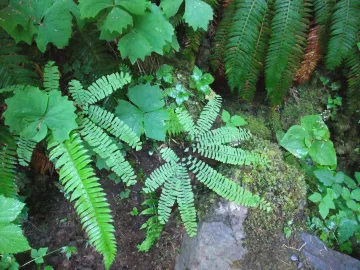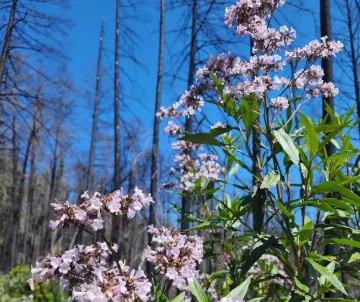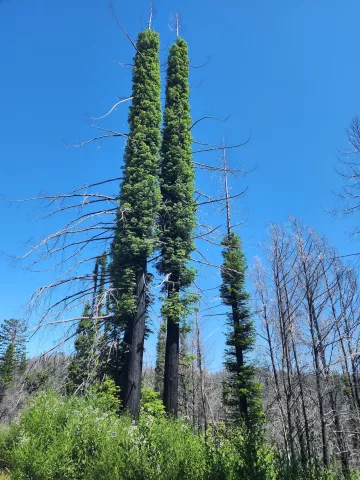
Established in 1902, Big Basin Redwoods is California’s oldest state park. In the heart of the Santa Cruz Mountains, its biggest attractions are its ancient coast redwoods. Some of these giants are more than 50 feet around and over 300 feet tall. At 1,000 to 2,500 years old, some may predate the Roman Empire. The park also offers spectacular views of the Pacific Ocean, lush waterfalls, and a fascinating natural and cultural history. Each season provides a different park experience. During wet winters, the intense greens of mosses contrast with the subtle colors of lichens and mushrooms. Rushing waterfalls and wildflowers abound in the cool, foggy spring. In summer, the park is a shady getaway from inland heat. Fall may be the most hospitable season, without storms or extreme heat. Home to the largest continuous stand of ancient coast redwoods south of San Francisco, park vegetation consists of old-growth and recovering redwood forest, with mixed conifer, oaks, chaparral, and riparian habitats. Elevations in the park vary from sea level to over 2,000 feet. The climate ranges from foggy and damp near the ocean to sunny, warm ridge tops. Three watersheds (Waddell Creek, East Waddell Creek, and Scott Creek) form the dominant landscape features of the park. Approximately 5,810 acres within the state park is designated a state wilderness, and together with the backcountry (10,540 acres) constitutes 85% of the park, offering quiet solitude among the large evergreen trees and steep canyon slopes.
Species
Wildlife habitats in Big Basin Redwoods SP are very diverse. Aquatic habitats within the park include marine, estuarine, fresh emergent marsh, lacustrine, and riverine. Treedominated habitats include montane riparian, coastal oak woodland, montane hardwood, montane hardwoodconifer, closed-cone pine-cypress, and redwood. The montane riparian habitat in Big Basin Redwoods SP includes willow-dominated forest and alder-dominated forest, both providing important cover and foraging habitat, as well as movement corridors for wildlife along streams. The shrub-dominated habitats found are coastal scrub, chamise-redshank, and mixed chaparral. There are also small areas of annual/perennial grassland in the park. This wide range of habitats supports a mixed assemblage of native wildlife.
Value as Water Supply

Big Basin Redwoods State Park encompasses most of the watershed of Waddell Creek and vice versa, thus the description of the hydrology of this park is largely based on what is known about this major Santa Cruz County stream and its tributaries. Big Basin Redwoods State Park also contains portions of about 20 other named streams and/or watersheds (including significant Waddell Creek tributaries) and over a dozen unnamed seasonal streams which drain substantial areas. Three sources of water have been developed and are currently used within the park. Water from Sempervirens Reservoir, which holds approximately 78 acre-feet, serves the Headquarters area including employee residences and campgrounds. The yearly withdrawal is approximately 34 acre-feet. RDO obtains water from a spring to supply park facilities and the ranger residence. The Nature and History Center uses water from an 11 foot-deep shallow well. All three sources have historically been adequate to meet typical demand, even during drought conditions, although the Nature and History Center well requires some water conservation measures during summer.
Local Organizational Involvement
The Loma Prieta Chapter's Singleaires outing section have a Semperviren Memorial Grove at Big Basin State Park. They continue to use that special redwood grove to dedicate trees to their departed members on an annual basis.The first tree was dedicated in 1982 and as of 2017, 96 of their former members have trees dedicated to them. Members of the Singleaires held fund raisers and special dinners in the 1970's & 1980's to raise money to reserve a dedicated grove from the Sempervirens managers of the grove dedication program. Their annual hike to the grove and dedication of trees usually occurs in May.
Current Situation
Land use patterns in the Santa Cruz Mountains have not changed significantly in the recent past. The timber industry, parks and open space, and private homes are the major land uses in the area. Big Basin Redwoods SP either shares borders or is in proximity to Castle Rock, Año Nuevo, Butano, and Portola Redwoods State Parks. Nearby are several other recreational and open space lands such as Pescadero Creek County Park and land owned by private nonprofit organizations such as the Sempervirens Fund and the Peninsula Open Space Trust. Private ownership patterns around the park generally consist of relatively large or very small parcels of land. Most of the area between the state parks surrounding Big Basin Redwoods SP remains undeveloped. A significant amount of land is owned by timber companies and is in timber production.
Threats

Plant and animal species composition has shifted and populations and habitats in and around the park have declined due to past land use and current human activities. The potential effects of the biggest threat, climate change, on Big Basin Redwoods State Park may include:
- Sea level rise. Increased saltwater intrusion into coastal aquifers, more beach areas and coastal wetlands areas inundated, and saltwater/freshwater interface and zone of brackish migrating inland. Coastal bluffs will be more exposed to wave energy and increased bluff erosion including scour and undercutting.
- Habitat loss and shifts. If coastal rainfall increases, most of the increase will be lost as runoff, and the dry summer/wet winter current climate pattern will persist. Warmer temperatures in summer will cause increased drying from evaporation. The combination of warmer temperatures and drier summer conditions may eliminate some plant communities and animal habitat, greatly fragment other habitat, and cause some habitats to shift. El Niño warming may encourage toxic algal blooms in bays and estuaries and depress ocean productivity offshore. The moisture-dependent wetland, riparian, and redwood forest plant communities could be especially affected at Big Basin
- Fire danger. As the climate warms and possibly dries, wildfires may become more frequent in some areas of California. The plant species in these communities are adapted to fire and typically regenerate, but increased fires could cause wildlife losses, threaten public safety and structures, and contribute to poor air quality in the region.
- Severe storms and flooding. Climate change may alter the frequency and intensity of winter storms, resulting in flooding and mudslides that could damage park infrastructure and access roads.
- Fishery habitat change. Over the next century, spawning streams may warm above temperatures suitable for cold water fish, such as salmon and steelhead. Reduced summer stream flow due to evaporation will also cause a loss of fish habitat.